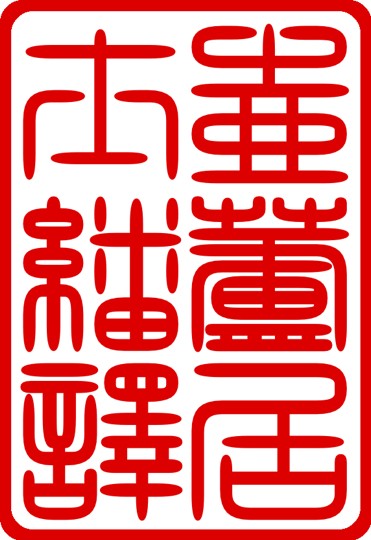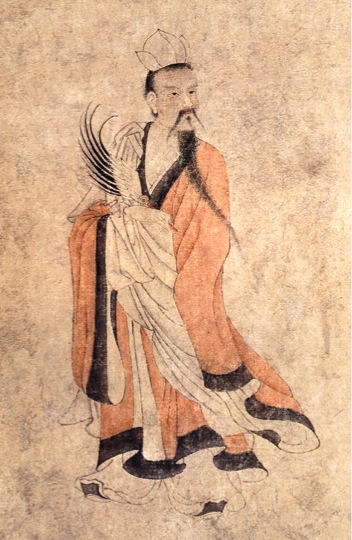Tea and the Materia Medica of Tao Hongjing
Tao Hongjing of the Liang dynasty
Baiying and Kucai
Baiying 白英, white flower. Its taste is sweet, its medicinal character is cold, and it is not poisonous. It cures chills and fever, the eight jaundices, indigestion and thirst, restores equilibrium and benefits qi 氣, the life force. Prolonged use lightens the body and extends life. One name for it is gucai 谷菜, herb of the valley; another name is baicao 白草, white herb. It is produced in the mountains and valleys of Yizhou. In spring season, pick the leaves; in summer, pick the stems; in autumn, pick the flowers, and in winter, pick the roots. The various prescriptions do not prescribe it, for it is only a food staple cooked in water for people to drink. It only grows in mountains and valleys…there is also baicao 白草, white herb, the leaves make soup to drink to relieve fatigue; however, the roots and flowers are not used. Only Yizhou has kucai 苦菜, a beverage drunk by the natives that promotes health and prevents disease. This is undoubtedly the case.
梁 陶弘景
本草經集注
卷第三
白英
味甘寒無毒
主治寒熱八疸消渴補中益氣
久服輕身延年
一名谷菜一名白草
生益州山谷
春采葉夏采莖秋采花冬采根
諸方藥不用
此乃有菜生水中人蒸食之
此乃生山谷…
又有白草葉作羹飲甚治勞而不用根花
益州乃有苦菜土人專食之皆充健無病疑或是此
Herb category of medicinals
Fruit, herbs, rice, and grains: nominal drugs of no practical application
Kucai 苦菜, bitter herb tea
Superior grade
Its taste is bitter, its medicinal character is cold, and it is not poisonous. It cures the five visceral organs and diseases, relieves gastric obstructions caused by eating grain, alleviates indigestion, intestinal distress, thirst, fever, and ulcers of the skin. Prolonged use calms the heart, benefits qi 氣 – the life force – quickens perception, lessens sleep, lightens the body, delays old age, dispels cold and hunger, and stays the decline of talent and the sublime nature. One name is tuku 荼苦; one, is xuan 選; and another, is youdong 遊冬. It grows in the mountains and valleys of Yizhou. It grows in the mountains and hills and along the roads. It lives through winter and does not die. It is picked on the third day of the third lunar month and dried in the shade. This herb is likely what is now known as ming 茗. One name for ming 茗 is tu 荼. It causes sleeplessness. It too does not wither in winter and is doubtless the same as that which grows in Yizhou. Only Yizhou has kucai 苦菜, which as stated is bitter. This herb kucai 苦菜 is already commented on in the entry of the herb baiying 白英, white flower, in the superior category of the first volume. It is written in the Record of Medicines by Master Tong that “the leaves of kucai 苦菜 grow lush in the third lunar month; in the sixth lunar month, flowers follow the growth of leaves; the stems are straight and the flowers, yellow; in the eighth lunar month, the seeds blacken; when the seeds fall, the roots extend their growth; in winter, the plant does not dry up. The present herb ming 茗 truly resembles this herb kucai 苦菜. The ming 茗 teas of Xiyang and Wuchang are comparable to those of Lujiang and Jinxi: they are all excellent. Easterners make only green ming 茗 tea. Ming 茗 tea is always beneficial. Of all beverages, ming 茗 tea compares with the edible leaves of various trees, asparagus sprouts, and china root: all are beneficial, bountiful, and valuable for their cooling properties. Badong has zhentu 真荼 tea, the leaves of which when fired twist and knot; these are made into a drink that causes sleeplessness. Zhentu 真荼 is undoubtedly similar to all these very teas. Now, the brewing of beautiful leaves to make tu 荼 tea compares with the herbal made of large black plums and its cooling effects. Nanfang has gualu mu 瓜蘆木, the wild tea tree, which is similar to ming 茗 tea in bitterness and astringency; the leaves are taken and crumpled into bits, brewed, and the liquor drunk. In consequence, there is sleeplessness all night long; indeed, for wakefulness the salt workers depend only on this drink. Along the breadth of all relationships, tea is of the utmost importance; first serve when guests arrive and add fragrant herbs.”
梁 陶弘景
本草經集注
卷第七
果菜米穀有名無實
菜部藥物
苦菜
上品
味苦寒無毒
主治五臟邪氣厭穀胃痹腸渴熱中疾惡瘡。
久服安心,益氣,聰察,少臥,輕身,耐老,耐饑寒,高氣不老
一名荼苦一名選一名遊冬
生益州川谷生山陵道傍淩冬不死
三月三日采,陰乾。疑此則是今茗
茗一名荼又令人不眠亦淩冬不凋而嫌其只生益州
益州乃有苦菜正是苦爾
上卷上品白英下已注之
《桐君藥錄》雲苦菜葉三月生扶疏六月花從葉出莖直花黃八月實黑實落根複生冬不枯
今茗極似此西陽武昌及盧江晉熙茗皆好東人只作青茗
茗皆有之宜人
凡所飲物有茗及木葉天門冬苗並菝皆益人余物並冷利
又巴東間別有真荼火燔作卷結為飲亦令人不眠恐或者此
世中多煮檀葉及大皂李作荼飲並冷
又南方有瓜蘆木亦似茗至苦澀
取其葉作屑煮飲汁即通夜不眠
煮鹽人唯資此飲爾交廣最所重客來先設乃加以香輩爾
Source
Tao Hongjing 陶弘景 (456-536), comp., “Baiying 白英” and “Kucai 苦菜),” Bencao jing jizhu 本草經集注 (Collected Commentaries to the Materia Medica), juan 3 and 7.
Figure
Artist unknown
Portrait of Tao Hongjing as a Daoist, detail
Yuan dynasty, 14th century
Album leaf: ink and color on paper
National Palace Museum, Taipei


